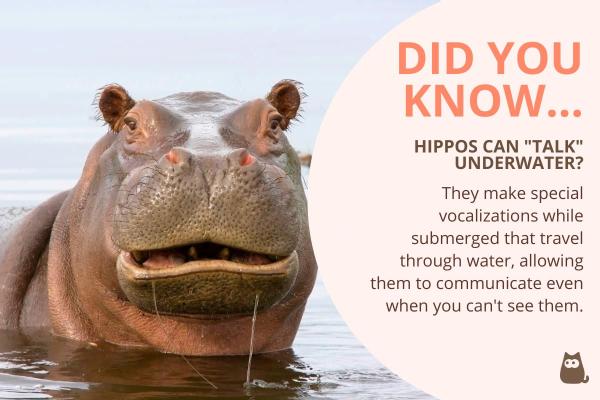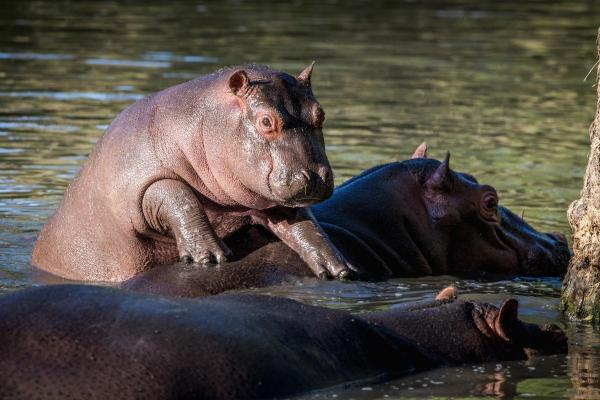10 Fun Facts About Hippos


Did you know hippos are one of the most dangerous animals in Africa despite their cuddly appearance? These massive, water-loving mammals are full of surprises. These mammals are more than river-dwellers with impressive yawns. Hippopotamuses shape entire ecosystems through their daily activities. Despite their popularity in zoos and documentaries, hippos remain misunderstood. Many people don't realize how fast they can move, how dangerous they can be, or how closely they're related to whales rather than pigs.
In this article, we’ll share 10 fun facts about hippos that will help you better understand their behavior, lifestyle, and why they’re so unique.
- Hippos have an unexpected family tree
- Hippos were once much more diverse
- They're incredibly heavy but surprisingly fast
- They're incredibly heavy but surprisingly fast
- They have special stomachs for plant digestion
- They feed at night
- They are built for life between land and water
- Their teeth are weapons, not just for eating
- Hippos change their environments
- They need our protection
Hippos have an unexpected family tree
Forget what you might have heard about hippos being related to pigs. Despite what people thought for centuries, genetic studies have revealed something much more surprising. Hippos' closest living relatives are actually whales and dolphins.
These animals belong to a group called Whippomorpha or Cetartiodactyla, having diverged from a common semi-aquatic ancestor about 60 million years ago. This ancestor gave rise to two evolutionary branches: one that fully adapted to aquatic life (whales and dolphins) and another that remained semi-aquatic (hippos).
Fascinated by hippos' connection to whales? Discover the remarkable evolutionary journey that transformed hippos' ancient cousins from land-dwelling mammals into the ocean giants we know today.

Hippos were once much more diverse
Today we only have two living species of hippopotamuses: the common hippo (Hippopotamus amphibius) and the pygmy hippo (Choeropsis liberiensis). But paleontological evidence shows that around 30 extinct species once roamed our planet. Some even lived on islands like Madagascar, where they evolved to be smaller because resources were limited.
These Madagascar hippos survived until quite recently, maybe just 1,000 years ago. Humans probably contributed to their extinction. Fossil records also show some truly massive ancient hippos that were nearly twice the size of today's hippos. Dring warmer periods, hippos even roamed as far north as Britain.
They're incredibly heavy but surprisingly fast
Common hippos are massive. Males weigh between 3,500-9,920 pounds, while females average around 3,000 pounds. They can be up to 16.5 feet long and over 5 feet tall at the shoulder. Only elephants and some rhinos are bigger land animals.
Despite weighing tons, hippos have little body fat. Their weight comes from dense bone and muscle. Though they look slow, they can run up to 30 mph in short bursts, which is faster than most humans. Their skin is about 2.4 inches thick, providing excellent protection from predators and the elements. This impressive size helps them dominate in the wild, especially when males compete for territory and mating rights.
They're incredibly heavy but surprisingly fast
The reddish substance often seen on hippos' skin isn't blood, it's natural sunscreen. Hippos produce a special secretion containing two compounds that block UV rays and fight harmful bacteria. This substance starts clear, then turns red-orange after exposure to air.
This adaptation is a perfect example of nature solving environmental challenges. The hippo's sunscreen works similarly to ours but developed independently through evolution. It's particularly important because hippos live in hot environments and often get wounds from territorial fights. Scientists are currently studying these compounds to develop new medicines for humans. These chemicals are produced from amino acids through specialized biochemical pathways that are unique to hippos.

They have special stomachs for plant digestion
Hippos have three-chambered stomachs, unlike cows which have four. This specialized digestive system allows them to break down tough plant fibers through fermentation. They consume mostly grass and vegetation but require less food than you might expect for animals of their size.
Their stomachs contain beneficial bacteria and microorganisms that break down plant material the hippo can't digest alone. These microbes receive a safe environment with abundant food, while helping the hippo extract nutrients from grass, a mutually beneficial relationship that evolved over millions of years.
Interestingly, scientists have occasionally observed hippos eating animal carcasses, including other hippos. This behavior puzzles researchers, since hippos are anatomically designed for plant consumption. They might engage in this unusual feeding when lacking certain nutrients or facing extreme environmental conditions.

They feed at night
Despite their enormous size, hippos eat relatively little. Only about 1-1.5% of their body weight each night (around 88 pounds of grass). They leave the water at sunset to feed, walking 3-5 kilometers along well-established paths they've used for generations. By morning, they've returned to the safety of the water.
These well-worn paths, often called "hippo highways," create important connections between habitats and influence plant communities across the landscape. Their selective grazing creates areas of shorter grass that benefits many other herbivores in the ecosystem.
Hippos don't need much food because they conserve energy by staying relatively inactive in water during daylight hours. They are selective eaters, using their wide, sensitive lips to choose the most nutritious plants while avoiding tougher, less beneficial ones.
They are built for life between land and water
Hippos have amazing adaptations for their semi-aquatic lifestyle. Their eyes, ears, and nostrils sit high on their heads, allowing them to stay mostly underwater while still seeing, hearing, and breathing. They can close their ears and nostrils when diving and hold their breath for up to five minutes.
They possess specialized hearing structures similar to their whale relatives, that allow them to detect sounds both above and below water. Unlike most mammals, hippos lack sweat glands, which is a logical adaptation for animals that cool themselves in water rather than through perspiration.
Perhaps most fascinating is that hippos don't actually swim. Instead, they "ground walk", which means they literally walk or run along river bottoms using their webbed toes for stability. They've even developed automatic breathing reflexes that cause them to surface every few minutes while sleeping, preventing them from drowning during rest.

Their teeth are weapons, not just for eating
Hippo teeth continue growing throughout their lives, with lower canines reaching up to 20 inches long. Their jaws can open to an impressive 180 degrees and bite with three times a lion's strength. These teeth are not primarily for eating, but serve instead as weapons for defense and displays of dominance.
Their teeth naturally sharpen themselves through grinding against each other, maintaining a dangerous edge without external wear. Male hippos use these weapons in territorial confrontations that can sometimes turn deadly. Evolutionary biologists believe these enormous teeth developed through sexual selection, and that females prefer males with larger teeth because it is an indicator of superior genetics.
A hippo's bite force measures around 1800 psi. This is powerful enough to crush a watermelon or small boat with ease. Yet despite this dangerous dental equipment, they feed by using their broad, muscular lips to pluck grass, then grinding it with their back molars. This demonstrates how different parts of their mouth evolved for completely different purposes.
Discover why hippos are considered among Africa's deadliest animals and what makes these seemingly peaceful giants so formidable.

Hippos change their environments
Hippos function as "ecosystem engineers" because they physically transform their habitats in ways that affect countless other species. They transport nutrients from land to water through their feeding and elimination habits. A single hippo moves approximately 1 ton of carbon from terrestrial to aquatic ecosystems each year.
This nutrient transfer significantly influences water chemistry, algae growth, and fish populations throughout river systems. The channels and pools hippos create provide essential refuge habitats during dry seasons. Some fish species have specifically evolved to thrive in hippo-modified environments.
Hippos also prevent waterways from becoming overgrown with vegetation. However, too many hippos in one area can create problems, because excessive nutrients can trigger harmful algae blooms that deplete oxygen. Healthy ecosystems require balanced hippo populations, highlighting why protecting these animals means preserving the vital ecological functions they perform.

They need our protection
Both hippo species face serious conservation challenges today. The common hippo is listed as Vulnerable, while the smaller pygmy hippo is Endangered. They're threatened by habitat loss, hunting for meat and ivory teeth, and increasing conflicts with expanding human populations.
Agricultural development, dam construction, and urban expansion fragment hippo habitats and disconnect the water sources they depend on. Climate change compounds these problems by altering rainfall patterns across Africa. Between 2009-2018, over 77,000 kg of hippo ivory entered international trade legally, not counting illegal trafficking.
This situation is particularly concerning because hippos reproduce relatively slowly. Females typically have just one calf every two years after an eight-month pregnancy. This reproductive strategy evolved in stable natural environments but makes population recovery difficult under hunting pressure.
Conservation efforts include establishing protected areas, creating wildlife corridors, developing sustainable tourism, and working with local communities to reduce conflicts. Saving hippos requires protecting entire freshwater ecosystems while addressing both immediate threats like poaching and long-term challenges like habitat loss and climate change.
If you enjoyed learning about hippo facts, dive deeper into the mysterious world of hippo mating rituals and the miracle of underwater births
If you want to read similar articles to 10 Fun Facts About Hippos, we recommend you visit our Facts about the animal kingdom category.
- Pan, X., Gong, D., Nguyen, D. N., Zhang, X., Hu, Q., Lu, H., Ganchuluun, T., He, F., Qi, Y., Jiang, Y., Qian, C., Iwase, A., Liao, Y., & Zhang, C. (2022). Diet and exercise: a review of molecular mechanism and pathophysiology. Signal Transduction and Targeted Therapy, 7, 381. https://www.nature.com/articles/s41392-022-01191-9
- Shuai, M., Fu, Y., Yu, Y., Li, C., Wang, G., Zhang, J., Yang, Y., Wang, Y., Zhang, B., Gan, Y., Li, P., Liu, Y., Dai, J., Yang, N., & Wang, L. (2022). Compositional and functional landscapes of the hippopotamus gut microbiome provide new insights into their aquatic adaptation. Cell Discovery, 8, 91. https://www.nature.com/articles/s41421-022-00483-2











